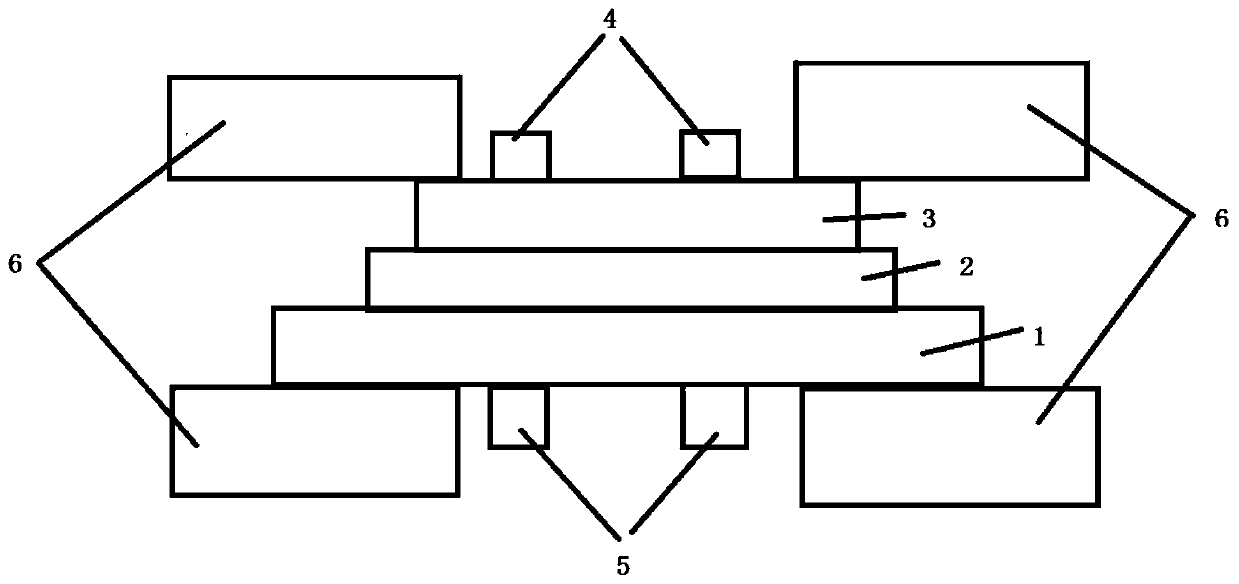Graphene / doped two-dimensional layered material Van der Waals heterojunction superconducting composite structure, superconducting device and manufacturing method thereof
A two-dimensional layered, graphene layer technology, applied in the direction of devices containing a node of different materials, superconductive devices, superconductor parts, etc., can solve the problem of large non-zero effective mass of carriers, superconducting transition Low temperature and other problems, to achieve the effects of good mechanical properties and machining properties, low material cost, and simple structure
- Summary
- Abstract
- Description
- Claims
- Application Information
AI Technical Summary
Problems solved by technology
Method used
Image
Examples
preparation example Construction
[0053] According to a third aspect of the present invention, a method for preparing the above-mentioned superconducting device is provided. The upper and lower layers are graphene, and the middle is a "sandwich" structure of a doped two-dimensional layered material as an example, including the following step:
[0054] With the aid of the supporting compression block, place the first graphene layer first, transfer the doped two-dimensional layered material on the first graphene layer, and then transfer the second graphene layer on the doped two-dimensional layered material on the graphene layer, and press it with two pairs of supporting compression blocks arranged at intervals; two pairs of upper and lower metal electrodes are respectively arranged on the first and second graphene layers, and after alignment, the tabs are welded to form positive and negative electrodes, and a superconducting device is obtained.
[0055] The preparation method of a typical "sandwich" structure s...
Embodiment 1
[0060] Monolayer graphene / p-doped monolayer hexagonal boron nitride (h-BN) / monolayer graphene van der Waals heterojunction structure. The uppermost layer and the lower layer are all single-layer graphene, and the middle layer is p-doped single-layer hexagonal boron nitride (h-BN). Each layer is stacked into a "sandwich" structure in a van der Waals heterojunction manner.
[0061] Among them, graphene was purchased from Nanjing Xianfeng Nano Material Technology Co., Ltd., p-doped single-layer hexagonal boron nitride was prepared by peeling off the corresponding bulk material repeatedly pasted with scotch tape, and p-doped by high-temperature diffusion method (doping concentration 1 to 10 -4 , at%). Such as figure 1 As shown, with the aid of an optical microscope, the above materials were stacked layer by layer. The length and width of the lowermost layer of graphene 1 are both 200 microns, the length and width of the middle single-layer hexagonal boron nitride 2 are about 10...
Embodiment 2
[0065] The difference between this embodiment and embodiment 1 is that the uppermost and lowermost layers are all single-layer graphene, and the middle layer is n-doped few-layer molybdenum disulfide (MoS 2 ), each layer self-assembles into a "sandwich" structure in a van der Waals heterojunction manner.
[0066] Few-layer molybdenum disulfide was obtained by vapor-phase deposition on graphene substrates based on the decomposition of ammonium tetrathiomolybdate. The decomposition of ammonium tetrathiomolybdate is based on the following two reactions:
[0067] (1)(NH 4 ) 2 MoS 4 +H 2 →2NH 3 +H 2 S+MoS 3 ;
[0068] (2)MoS 3 →MoS 2 +S.
[0069] Wherein (1) formula reaction temperature is 500 ℃; (2) formula reaction temperature is about 950 ℃.
[0070]Place the suspended graphene (the electrode is below) that is pressed by two pairs of supporting compression blocks and has deposited metal electrodes in the tube furnace, and take measures to close the lower part so that...
PUM
| Property | Measurement | Unit |
|---|---|---|
| tensile strength | aaaaa | aaaaa |
| superconducting critical temperature | aaaaa | aaaaa |
| superconducting critical temperature | aaaaa | aaaaa |
Abstract
Description
Claims
Application Information
 Login to View More
Login to View More - R&D
- Intellectual Property
- Life Sciences
- Materials
- Tech Scout
- Unparalleled Data Quality
- Higher Quality Content
- 60% Fewer Hallucinations
Browse by: Latest US Patents, China's latest patents, Technical Efficacy Thesaurus, Application Domain, Technology Topic, Popular Technical Reports.
© 2025 PatSnap. All rights reserved.Legal|Privacy policy|Modern Slavery Act Transparency Statement|Sitemap|About US| Contact US: help@patsnap.com

